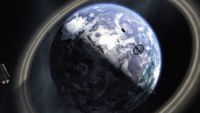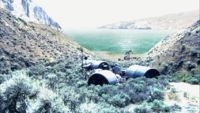Algae planet: Difference between revisions
More languages
More actions
grammar |
corrections + in-universe style + removing material not related to topic + episode tags |
||
| Line 2: | Line 2: | ||
[[Image:Algae planet base camp.jpg|thumb|right|200px|Colonial base camp on the surface.]] | [[Image:Algae planet base camp.jpg|thumb|right|200px|Colonial base camp on the surface.]] | ||
The '''algae planet''' is an unnamed, habitable world possessing a debris ring, and oceans and seas on its surface. It is | The '''algae planet''' is an unnamed, habitable world possessing a debris ring, and oceans and seas on its surface. It orbits an unstable sun, and is located in close proximity to an intense, blinding, and highly radioactive [[Passage (star cluster)|star cluster]]. | ||
After the [[The Fleet (RDM)|fleet of surviving Colonial ships]] discovers its food stores are contaminated and sends out scouts to search for a new food source, [[Sharon Agathon]] returns from her recon of the planet and confirms that edible, protein-rich algae grows there. The fleet makes the dangerous crossing of the star cluster, and sets up stations on the planet to harvest and process the algae ([[TRS]]: "[[The Passage]]). | |||
Two weeks later, as harvesting is wrapping up, [[Galen Tyrol]] is inexplicably drawn to a mysterious structure, the [[Temple of Five]], which was built by the [[Thirteenth Tribe (RDM)|Thirteenth Tribe]] approximately four thousand years before. The [[Sacred Scrolls]] describe this as the location of the [[Eye of Jupiter]], an artifact that can potentially point the way to the Thirteenth Tribe's destination, [[Earth (RDM)|Earth]]. Shortly afterwards, a [[Cylons (RDM)|Cylon]] fleet appears over the planet, also seeking the Eye, leading to the [[Battle of the Algae Planet]] ([[TRS]]: "[[The Eye of Jupiter]]"). | |||
As predicted by [[Felix | As predicted by [[Felix Gaeta]], the planet's unstable sun eventually goes nova. Before escaping the planet's surface, Tyrol realizes that the nova itself is the clue, leading the fleet to the [[Ionian nebula|location of a similar nova millennia earlier]]. Both fleets jump away just as the nova's shockwave consumes and obliterates the planet ([[TRS]]: "[[Rapture]]"). | ||
<div style="clear:both;"></div> | <div style="clear:both;"></div> | ||
Revision as of 23:31, 20 August 2013


The algae planet is an unnamed, habitable world possessing a debris ring, and oceans and seas on its surface. It orbits an unstable sun, and is located in close proximity to an intense, blinding, and highly radioactive star cluster.
After the fleet of surviving Colonial ships discovers its food stores are contaminated and sends out scouts to search for a new food source, Sharon Agathon returns from her recon of the planet and confirms that edible, protein-rich algae grows there. The fleet makes the dangerous crossing of the star cluster, and sets up stations on the planet to harvest and process the algae (TRS: "The Passage).
Two weeks later, as harvesting is wrapping up, Galen Tyrol is inexplicably drawn to a mysterious structure, the Temple of Five, which was built by the Thirteenth Tribe approximately four thousand years before. The Sacred Scrolls describe this as the location of the Eye of Jupiter, an artifact that can potentially point the way to the Thirteenth Tribe's destination, Earth. Shortly afterwards, a Cylon fleet appears over the planet, also seeking the Eye, leading to the Battle of the Algae Planet (TRS: "The Eye of Jupiter").
As predicted by Felix Gaeta, the planet's unstable sun eventually goes nova. Before escaping the planet's surface, Tyrol realizes that the nova itself is the clue, leading the fleet to the location of a similar nova millennia earlier. Both fleets jump away just as the nova's shockwave consumes and obliterates the planet (TRS: "Rapture").
Notes
- Algae are simple aquatic organisms. Many are actually processed on the real-world Earth for use, among other things, as nutritional additives or foods.
- The algae planet parallels New Caprica as an intermediate home on the journey to Earth and appears to be a much more hospitable environment for human life. Its suitability as a permanent home, though, is rendered moot by the status of its sun, coupled with the fact that, like Kobol, it offers no protection from the Cylons.
